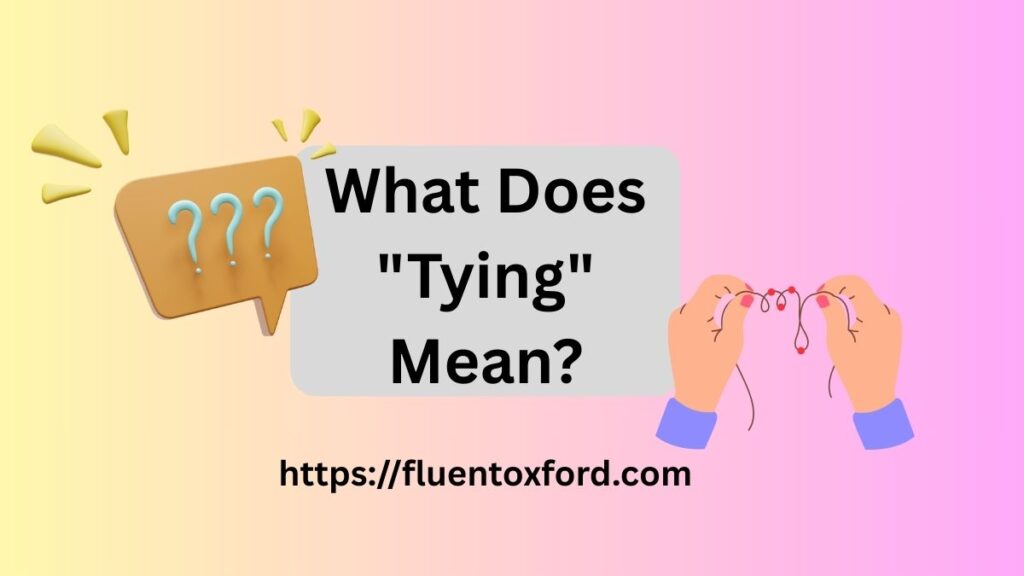Tying Or Tieing? The Right Way To Spell It refers to the correct spelling of the present participle of the verb “tie,” which means to fasten or secure something using a knot. In English grammar, when adding “-ing” to a verb ending in a silent “e,” the “e” is dropped. Following this rule, the correct spelling is “tying,” while “tieing” is incorrect. This small but essential rule helps maintain consistency in writing and ensures proper word formation. Understanding the difference prevents common spelling mistakes and improves overall language accuracy.
Spelling errors, even minor ones, can make writing appear unprofessional and confusing. Tying Or Tieing? The Right Way To Spell It is a common dilemma for many, leading to hesitation when writing. Words that seem simple can sometimes cause the most confusion. Mastering small grammar rules like this one enhances confidence in communication and prevents errors that might affect credibility.
Knowing the correct form of Tying Or Tieing? The Right Way To Spell It is crucial for effective writing. The word “tying” follows a standard English rule, making it the only correct spelling. Whether writing an academic paper, an email, or a creative piece, using the proper form improves clarity and precision. Strengthening spelling skills with simple rules like this ensures better communication and avoids unnecessary mistakes.
Why Is There Confusion?

The confusion between tying and tieing comes from irregular spelling rules in English. Many verbs keep the final “e” when adding “-ing,” leading some to think “tieing” is correct. However, “tie” follows the rule of dropping the silent “e” before adding “-ing,” making “tying” the correct form.
The incorrect spelling “tieing” appears logical to some because similar words behave differently. This inconsistency in English spelling causes doubt, especially for learners and writers unfamiliar with verb conjugation rules.
The confusion between “tying” and “tieing” stems from English orthography, where verb conjugations don’t always follow a predictable pattern. Let’s break down the reasons:
- The Final -e Rule: Many verbs drop the final -e before adding “-ing,” such as “make” → “making.” However, “tie” follows a special rule.
- Phonetics & Pronunciation: “Tying” sounds different from “tieing,” leading some to believe both spellings are acceptable.
- Rare Spelling Pattern: Verbs ending in “-ie” follow a distinct pattern where “-ie” changes to “y” before adding “-ing.”
Understanding these linguistic factors can help eliminate common confusion about similar words.
Tying vs. Tieing: Which One Is Correct?
Correct Spelling: “Tying”
The only grammatically correct spelling is “tying.” This follows the spelling rules for verbs ending in “-ie.” The incorrect form, “tieing,” does not exist in standard English. When choosing between tying and tieing, the correct spelling is tying. In English, when a verb ends in a silent “e,” the general rule is to drop the “e” before adding “-ing.” This is why “tie” becomes “tying” instead of “tieing.”
The incorrect spelling, tieing, may seem logical, but it does not follow standard grammar rules. Understanding this rule helps avoid mistakes in writing. Whether you’re talking about tying shoelaces, knots, or ribbons, always use “tying.” Learning small spelling rules like this improves writing accuracy and boosts confidence in English communication.
| Word | Incorrect Form | Correct Form |
| Tie | Tieing | Tying |
| Die | Dieing | Dying |
| Lie | Lieing | Lying |
As shown above, words ending in “-ie” undergo a transformation where “-ie” changes to “y” before adding “-ing.”
Why “Tieing” Is Incorrect
“Tieing” is incorrect because it does not follow standard English spelling rules. When adding “-ing” to a verb ending in a silent “e,” the correct rule is to drop the “e” before adding the suffix. This is why “tie” becomes “tying” instead of “tieing.”
The incorrect spelling may seem logical to some, but it is not recognized in proper English usage. Understanding this rule helps avoid spelling mistakes and improves writing clarity. Always use “tying” in formal and informal writing.
- It doesn’t follow standard inflectional morphology.
- It disrupts phonetics & phonology, making it harder to pronounce.
- English verb conjugation does not permit “tieing.”
If you see “tieing” in writing, it’s likely a mistake. Always use “tying.”
What Does “Tying” Mean?

“Tying” is the present participle of the verb “tie,” which means to fasten, secure, or connect something by making a knot or loop. It is commonly used when referring to tying shoelaces, tying a rope, or tying a ribbon. The word follows standard English grammar rules, where the silent “e” in “tie” is dropped before adding “-ing.”
“Tying” can also be used in a figurative sense, such as tying loose ends or tying someone to a commitment. Understanding the correct spelling and meaning of “tying” helps in both written and spoken communication.
“Tying” is the present participle of “tie” and means:
- Fastening or securing something using a knot or string.
- Example: “She is tying a knot in her shoelaces.”
- Connecting or linking something together.
- Example: “The new policy is tying employee benefits to performance.”
- Ending a competition in a draw.
- Example: “The teams are tying at 2-2.”
Understanding its correct usage ensures you never make the mistake of writing “tieing.”
The -ie to -y Rule in English Grammar
In English grammar, the -ie to -y rule states that when adding “-ing” to a verb ending in -ie, change -ie to -y before adding “-ing. ** For example, “tie” becomes “tying,” and “die” becomes “dying.” This rule prevents awkward spelling.
The transformation of “-ie” to “y” before “-ing” applies to several common verbs:
| Base Word | Present Participle |
| Tie | Tying |
| Die | Dying |
| Lie | Lying |
| Vie | Vying |
| Untie | Untying |
This special rule simplifies pronunciation and prevents awkward spelling.
Common Synonyms for “Tying”
Depending on the context, you can use several lexical semantics alternatives:
- Fastening: “She is fastening her shoelaces.”
- Securing: “He is securing the rope to the dock.”
- Binding: “The lawyer is binding the documents together.”
- Attaching: “They are attaching the name tag to the bag.”
- Wrapping: “ She is wrapping a scarf around her neck to stay warm.”
- Linking: “He is linking the chains together to secure the gate.”
Using synonyms can improve sentence variety while avoiding redundancy.
Example Sentences Using “Tying”
Everyday Usage
- “She is tying the knot on her apron.”
- “I am tying my hair back before jogging.”
Idioms & Phrases
- “Tying the knot”—getting “married.
- Example: “They are tying the knot this weekend.”
- “Tying up loose “ends“—completing unfinished business.
- Example: “The detective is tying up loose ends in the case.”
Mastering these phrases improves both spoken and written English.
Etymology of “Tying”
The word “tie” originates from Old English tīegan, meaning “to fasten or bind.” Over time, English evolved its morphology, standardizing “tying” as its present participle. The word “tying” comes from the verb “tie,” which originates from the Old English “tīegan,” meaning to bind or fasten.
It traces back to the Proto-Germanic “taugijan” and Proto-Indo-European “deuk-“ (to lead or pull). Over time, English adopted the -ie to -y rule, forming “tying.”
| Language | Word | Meaning |
| Old English | tīegan | Bind, fasten |
| Middle English | tie | Secure, attach |
| Modern English | tying | Fastening, securing |
Understanding its history helps reinforce why “tying” remains the correct spelling.
Mnemonic Rhyme to Remember the Rule

“Drop the E, add I-N-G,
Tying is the way, you see!
Just like die turns into dying,
Follow the rule—no denying!”
This simple rhyme helps remember the rule: when adding “-ing” to a verb ending in silent -e, drop the e first. So, “tie” becomes “tying,” not “tieing.” Using rhymes makes spelling rules easier to recall!
This memory trick simplifies verb conjugation and prevents spelling mistakes.
Conclusion
Understanding Tying Or Tieing? The Right Way To Spell It is important for correct writing. The correct spelling is “tying,” following a simple grammar rule. Dropping the silent “e” before adding “-ing” makes the word easier to say and write. “Tieing” may seem right, but it does not follow standard English spelling rules. Knowing this helps avoid mistakes and improves writing skills.
English can be tricky, but learning small rules makes a big difference. Tying Or Tieing? The Right Way To Spell It is a common doubt, but now you know the answer. Using “tying” correctly in emails, essays, or everyday writing shows good grammar knowledge. Paying attention to such details makes writing clear and professional. With this simple rule, you can be more confident in your spelling.
FAQs
1. Is “tieing” ever correct in any form of English?
No, “tieing” is incorrect in standard English. The correct spelling is “tying.”
2. Why does “tie” become “tying” instead of “tieing”?
English spelling rules state that verbs ending in “-ie” change the “-ie” to “y” before adding “-ing.”
3. Does this rule apply to all verbs ending in “-ie”?
Yes, words like “die” → “dying”, “lie” → “lying”, and “vie” → “vying” follow the same pattern.
4. Can “tying” mean something other than making a knot?
Yes! It can also mean connecting things (e.g., “tying work performance to bonuses”) or ending in a draw (e.g., “The teams are tying at 2-2.”).
5. How can I remember the correct spelling easily?
Use this mnemonic rhyme: “Drop the -e, change to y, add -ing, and now it’s right!”

As an admin at Fluent Oxford, Maida Queen is the driving force behind our vibrant learning community. With a deep passion for English language education, she ensures that our platform remains a dynamic, engaging, and supportive space for learners worldwide.
Maida expertly manages content, assists users with their grammar and fluency queries, and fosters an interactive environment where learning feels effortless and enjoyable. Whether you need guidance, motivation, or just a friendly face in the Fluent Oxford community, Maida is always there to help you reach your English language goals.








